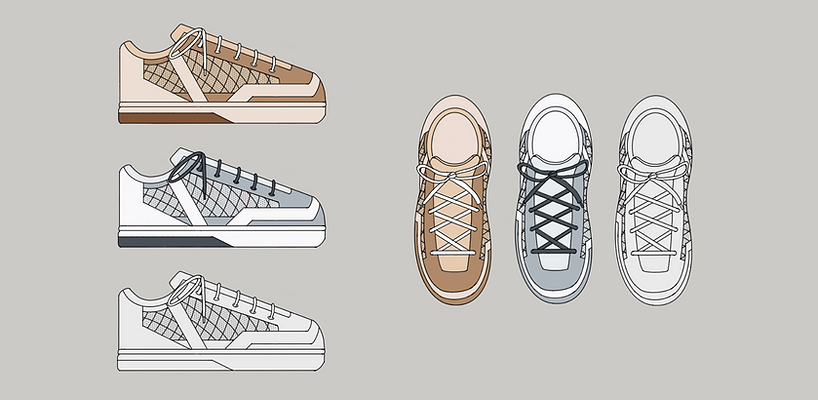top of page
GROUNDED
ATHLETIC SHOE
OBJECTIVE
OVERVIEW
My group was tasked with creating a design prototype that solved an existing issue in the world. After some searching, we found a hole in the footwear market and sought to answer the question “How might we create a shoe that is both supportive and stylish?". We wanted to make something that would set a new standard for what a shoe could include and be.
SCOPE: End-to-End Design
TEAM: Anagha Y, Fernando J, Annie Y, Gavin G
TOOLS: Adobe Photoshop, Miro
TIMELINE: 6 weeks (40 hours)
RESEARCH
Our group conducted a survey as the first step in the process to better understand how a wider audience of real people felt about modern shoes. We asked questions about attributes they prioritized in footwear, the problems they faced with shoes, and general features they wished more shoes had. Users had a lot of issues with modern shoes, especially about them squishing toes and lacking arch support. This gave us a better sense of direction with how to conduct our secondary research afterward.
We then started our secondary research to better understand shoes as a whole. This research involved looking at multiple academic papers and web articles to gather general information about shoes. The results of this secondary research confirmed our initial findings about shoes squishing toes and lacking arch support and also shed light on additional issues such as chafing and general foot pain.
After conducting our surveys and secondary research we used the data we gathered to create questions for an interview. We then performed four semi-structured interviews, each of us interviewing one person. The questions we asked looked to gather additional information about people's preferences when it came to fashionability and comfortability in shoes as well as gaining more information about the features people dislike about modern shoes. Some of the insights gained from these interviews included people preferring light, minimal, athletic shoes, discontent with modern shoes' inability to mold to the user's foot, and further confirmation of people's dissatisfaction with the size of toe boxes.
SKETCHING
The next step was to sketch out a few ideas to have a design to iterate and improve upon later on in the process. We drew 8 design ideas, each of us creating two. We used the quantitative data gained from our surveys and included solutions to the top 3 pain points (lack of arch support, chafing, and squished toes) in each of our sketches. Additionally, we also made sure to use the qualitative data gathered around the design of the shoe to ensure a minimal and classic design. Below are four of our most promising sketches.

_edited.jpg)

_edited.jpg)
LOW-FIDELITY PROTOTYPE
Our team was then tasked with choosing one of our design ideas and creating a low-fidelity prototype. While we had initially planned on making the shoe, the shoe-building process ended up posing a bigger challenge than expected. To remedy this issue I created a design blueprint that could instead be handed off to a team to build out the actual shoe.
When deciding on which initial idea to expand upon we mostly focused on the visual aspect of the design, as all of our shoes included fairly similar features. My initial sketch ended up being chosen because of its sleek and modern design that was reminiscent of shoes currently on the market that our research candidates preferred.

HIGH-FIDELITY PROTOTYPE
After getting more feedback from users on the initial prototype we were able to move forward with the high fidelity prototype. Some of this feedback included wanting multiple colorways as well as additional information about the materials of the shoe. The high-fidelity prototype I created included 3 drawings of our design, the first being a detailed drawing of the shoe in three different colorways for people to choose from.
.png)
The second was a drawing detailing the materials of the shoe and which parts were made out of each specific material. The materials were chosen based on the secondary research conducted at the beginning of the design process.

The last drawing was created to show off the specific features that were built into the shoe to make it more comfortable for users. The lack of all of these features was something that was constantly complained about by users in our secondary research, survey, and interviews.

REFLECTION
We shot for the stars when it came to this project. While we ended up making the detailed drawings of the shoe, we initially wanted to create a physical prototype. I am still really happy with the final product though, especially considering that we had a rapid turnaround when it came to creating the final prototype.
I also learned a lot about how to conduct research, such as how to get interviewees to expand upon information as well as question planning and recruiting for surveys. This was also the first design-based group project I had worked on. It taught me how to work with other people especially when it came to differences in opinion and trying to combine ideas. I am appreciative of the experience I gained working on this project and how it has prepared me to work through the full UX design process in the future.
bottom of page